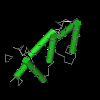?
 
Regulator of G protein signaling (RGS) domain found in the RGS16 protein The RGS (Regulator of G-protein Signaling) domain is an essential part of the RGS16 protein. RGS16 is a member of the RGS protein family, a diverse group of multifunctional proteins that regulate cellular signaling events downstream of G-protein coupled receptors (GPCRs). RGS proteins play critical regulatory roles as GTPase activating proteins (GAPs) of the heterotrimeric G-protein G-alpha subunits. The RGS domain controls G-protein signaling by accelerating the GTPase activity of the G-alpha subunit which leads to G protein deactivation and promotes desensitization. As a major G-protein regulator, RGS domain containing proteins are involved in many crucial cellular processes such as regulation of intracellular trafficking, glial differentiation, embryonic axis formation, skeletal and muscle development, and cell migration during early embryogenesis. RGS16 is a member of the R4/RGS subfamily and interacts with neuronal G-alpha0. RGS16 expression is upregulated by IL-17 of the NF-kappaB signaling pathway in autoimmune B cells. |
